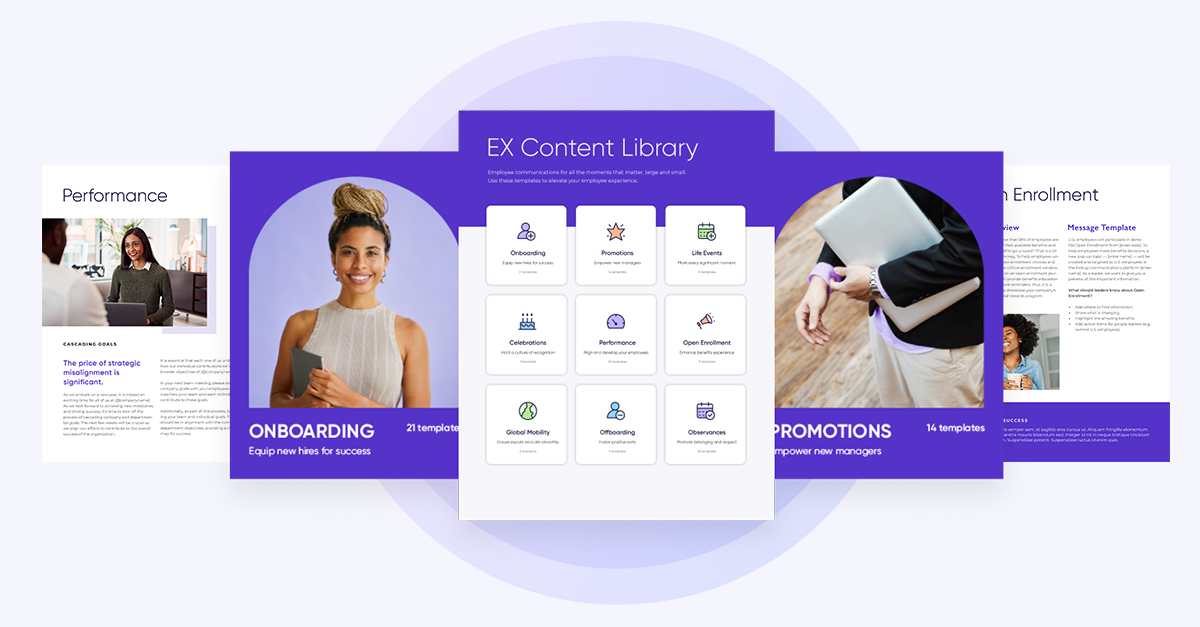A few weeks ago I took part in an expert webinar, Internal communications and human resources: Why they’re stronger together at building employee engagement. The event, held in conjunction with People Management Magazine and PR Week, discusses how IC and HR teams can align their efforts to become a powerhouse of influence and work together to provide the best possible experience for employees.
Hosted by Eleanor Whitehouse, Acting Editor of People Management, and together with Oli Howard, Membership Strategy Lead at CIPD, and Jennifer Powell, Director of The Resolution Partnership Limited, we discussed the importance of HR and internal communications (IC) collaboration, the barriers to this, and what strategies can be used to overcome them.
We all agreed that in the current climate, where organizations are still having to adapt to the changing pandemic situation, IC and HR are more crucial than ever in engaging all employees to help workforces through the ongoing transitions.
And with good reason. A recent Forbes report, The Experience Equation, states that 89% of surveyed executives at companies that consider themselves revenue-growth leaders agree that better employee experience (EX) leads directly to better customer experience (CX). As we all know, a better customer experience leads to better business results all around.
Communications for the sake of communications sake doesn’t help the employee or the organization. The ability to be quite strategic and focus on the intent of the comms and initiative and be able to reach the right employee will drive a better experience for the individual and outcome for the organization.
—Nicole Alvino, Firstup
When the alignment is off
Unfortunately, sometimes a lack of alignment between IC and HR teams can hamper those efforts, with the two functions not always working together as closely as they might, working in silos, or even worse, competing for employee attention.
As Oli Howard put it, both functions want to create the best possible employee experience to attract and retain talent and then put that talent to good use for the organization. Neither can really get their jobs done to full effect without the other, but the relationship can be a tricky one.
One of the reasons for this is that, according to Gallagher, only a quarter of IC people sit within HR directorates, with the biggest proportion sitting within Corporate Comms. The rationale for this is that IC shares more in terms of skills with other comms experts and that it aids alignment between internal and external communication – makes sense right? On the other hand, IC and HR have a shared responsibility for the employee experience, which is equally important. So it’s vital that when IC sits outside the HR directorate, there is a really strong working relationship in place.
It is also often the case that IC strategies and people strategies are not developed in tandem, or even in a way that allows them to exert mutual influence on each other, which can lead to tension down the line about what messages are being prioritized. Unclear accountabilities for things that both functions have a stake in – such as engagement surveys, communication training, employee forums – can also cause friction.
Jennifer’s viewpoint was that ownership was one of the key areas of conflict, with both sides feeling that they ‘know the people’ best. HR has lots of information on the demography of the organization and knows what is coming down the road that will influence employee mood, whereas IC ‘owns’ the comms channels, and know how to use them to best effect.
So what can be done to bind IC and HR together in a more cohesive, constructive way in order to ensure an excellent employee experience for all?
Putting the pieces together
For me, so much of the conflict can be dissipated by focusing on the needs of the employee first and foremost. This conversation also really reminded me of our recent research, Digital Employee Experience: Raising the bar, about the need for HR and IC to work more closely with IT, the risks of not doing so, and the benefits it can bring.
What I’ve seen work best with so many of our clients is when IC and HR are in the room together, along with IT, and really get down to the nitty-gritty of what the problem is and what the organization wants to achieve. This means stepping back and thinking of the different personas in play. It’s about really trying to understand what is needed for each individual employee to do their job to the best of their ability – how communications can meet them where they are, regardless of role, location, or shift. When IC and HR take the time to think through the current gaps and opportunities and collaborate in a way that puts the employee needs at the heart of every decision, it will have far-reaching benefits all the way through the organization, including on the bottom line.
IC and HR help employees really understand what their role is. Influencers in an organization are not the ones in the hierarchy but the ones that are the go-to people that turbocharge any change. The ones that can sabotage any change! HR and IC together know who those people are and how to access them and reach them.
—Jennifer Powell, The Resolution Partnership Limited
During the webinar, all of us agreed that there are some key areas where there is enormous potential for working together that can help build the relationship, mutual respect, and drive positive behaviors throughout the business.
- The first of these was the need to collaborate to translate organizational strategy into a clear sense of what is required from the workforce. This process, which should absolutely include scrutinizing and challenging it, will bring clarity and alignment that will enable both functions to jointly consider what is most important and what tactics might be most effective in delivering against those priorities.
- Secondly, and this is a really big one for me, is supporting managers with communication. Technology has allowed communicators to open direct lines to employees more than ever before, and there are massive advantages to that. But there is a huge body of evidence around the role that direct supervisors have over employees’ experience at work (and a large part of that is around communications). Employees want to hear from their managers, they want to be engaged by them. For this reason, it is imperative that the use of technology does not circumvent managers, but instead enables, empowers and supports them in engaging directly with their teams.
- HR and IC also have a critical role in creating an environment in which managers can succeed – identifying the behaviors needed to drive the best employee experience and providing the right blend of training, development, peer support, briefing materials, digital channels and incentives, to support that.
- Another area of opportunity for IC and HR to join forces to great effect is in promoting employee voice. Whether this is done through directly involving people in shaping strategic or operational decisions, looking for innovative ideas, or seeking feedback on the employee experience and how you can improve it, it’s a job that calls on the resources and expertise of both functions. It’s also important that there is then a joined-up analysis of all the sources of insight in order to be able to determine what’s really important to employees.
Solving with data
This leads me nicely onto the importance of data – or, more specifically workforce intelligence. For me, this is the future of how IC and HR will work together. The rich, deep data, gleaned from being able to track different engagements gives us massive opportunities in several areas, such as identifying high potential employees, correlating engagement around communications with retention, or even spotting early signs of attrition, that then enables leaders to jump in and take remedial action.
At Firstup we have started to see organizations go deeper with data to provide a better experience for employees and give the organization valuable insights into different sections of the workforce and how to motivate them and align them with the strategic pillars. This, I believe, will form the foundation of understanding how we can best reach every single employee, in the way that they want to be reached. In a way that is effective.
The benefit to everyone
The benefits of IC and HR working together in a cohesive joined-up manner cannot be underestimated – both for the organization as a whole and the individual.
The best way to improve your internal profile is to do good impactful work that makes a difference to the organization and your chances of achieving that are greatly enhanced if you have a really great working relationship with the other team.
—Ollie Howard, CIPD
When asked about the benefits to the individual as well as the organization, Oli stated that the best way to improve your internal profile is to do good impactful work that makes a difference to the organization, and your chances of achieving that are greatly enhanced if you have a great working relationship with the other. Jennifer agreed – pointing out that HR and IC often have a unique perspective that enables them to identify blind spots, and are fearless in pointing them out, earning them a reputation as a trusted advisor, which can have massive positive ramifications for their future career.
HR and IC have a unique perspective in that they can spot the blindspots and are absolutely fearless in pointing it out, and in that way, they become the trusted advisors.
—Jennifer Powell, The Resolution Partnership Limited
We ended the webinar on a high – optimistic that if HR and IC can align their efforts, they could be one another’s strongest internal allies. As Oli stated at the start of the session, both functions want the same thing – to drive a better employee experience for all. With the growing acknowledgment of the importance of employee experience, coupled with technology allowing for massive leaps forward in terms of the Digital Employee Experience (DEX), this is an exciting time to be part of IC and HR, and as Jennifer rightly said, “You are completely unstoppable if you are working together.”
I’ve seen examples of this time and time again – particularly with those in IC and HR who have demonstrated that the functions can work together to achieve measurable outcomes. Whether it’s that they have been able to effectively deliver targeted personalized comms, to be able to report how strategic initiatives have been adopted, or just that they have been able to reach the frontline more effectively, this is something that the C-Suite notices.






